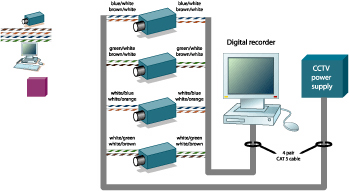
1. Which of the following is an advantage of digital recording?
a. More accurate color and detail in playback mode
b. Advanced and quicker searches
c. Smaller storage media
d. No loss of quality when copying images
e. All of the above
2. Which of the following is an example of digital compression?
a. JPEG
b. Wavelet
c. MPEG
d. All of the above
e. None of the above
3. What factors affect the number of days of video that can be stored by a digital recorder?
a. Resolution
b. Frames per second
c. Activity
d. Number of cameras
e. All of the above
4. Which of the following can be used to detect tampering with digital images?
a. Watermarks
b. Digital signatures
c. Encryption
d. Any of the above
5. Archiving digital images can be accomplished only by using DAT tapes.
a. True
b. False
6. Which of the following is an example of a rewritable DVD?
a. DVD+RW
b. DVD-RW
c. DVD-RAM
d. Any of the above
7. A mathematical technique of creating missing data is called
a. interpolation.
b. lossless.
c. artifacts.
d. None of the above
8. Blemishes or distortions in an image generated by electrical noise or other factors of an imaging system is called
a. interpolation.
b. lossless.
c. artifacts.
d. None of the above
9. CODEC is shorthand for covert decoding.
a. True
b. False
10. Digital video recorders cannot be put on a local area network (LAN).
a. True
b. False
11. An 8:1 compression ratio will reduce a 1 Mb image file to approximately
a. 1 Kb
b. 15 Kb
c. 128 Kb
d. None of the above
12. RAIDs can be used to increase the storage capacity of a digital recording system.
a. True
b. False
13. A compression technique that reduces the size of the image with-
out loss of information is called
a. interpolation.
b. lossless.
c. artifacts.
d. None of the above
14. CDs can store more data than a DVD.
a. True
b. False
15. Digital images stored on a computer can be
a. printed to standard printers.
b. sent with e-mail.
c. saved to a removable disk.
d. Any of the above
None of the above
5-Minute Tech Quiz Answers
Here are the answers to the 5-Minute Tech Quiz.1. e - In addition to eliminating the problems of head cleaning/replacement, DVRs provide high image quality that does not deteriorate over time; allows searches by time, camera, or motion; and the images can be stored on traditional computer storage devices, which are much smaller that traditional VHS tapes.
2. d
3. e - All of these factors determine the amount of data per image that is stored and as such will affect the number of days of storage. In addition, the size of the disk and type of compression employed will also affect the storage time.
4. d
5. b - While DAT tapes may be used to archive video data, other options may be CDs DVDs, removable hard drives, or any other mass storage media. The options available depend upon the specific unit and manufacturer.
6. d
7. a
8. c
9. b - CODEC is shorthand for Compression/Decompression. It is used to describe the technique used to compress data and may be accomplished with hardware, software, or a combination of both.
10. b - Depending upon the specific product and manufacturer you may be able to connect a DVR to a LAN or to a standard modem for remote viewing/administration.
11. c
12. a - Depending upon the specific product and manufacturer RAID or Redundant Array of Independent Disks can be used to increase storage capacity.
13. b
14. b - Typically CDs can store up to 650 Mb of data, while DVDs, can store 4.7 Gb or more.
15. d - Since digital images can be stored as standard computer files they can be treated in the same way you treat any image file.
